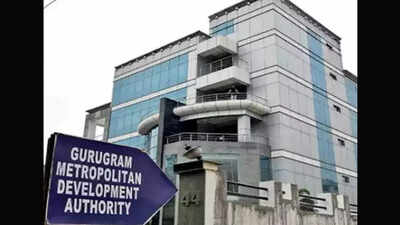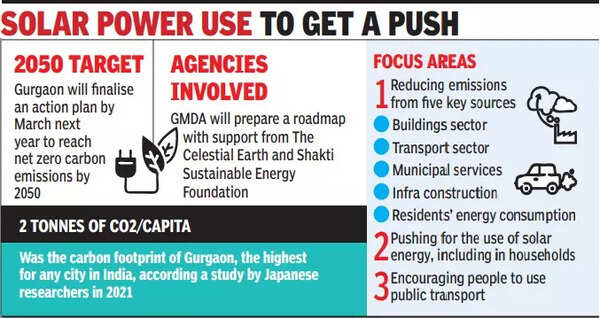- News
- City News
- gurgaon News
- How Gurugram plans to achieve net zero carbon goal by 2050: GMDA roadmap by next year
How Gurugram plans to achieve net zero carbon goal by 2050: GMDA roadmap by next year

Gurugram Metropolitan Development Authority
GURUGRAM: By March 2023, an action plan will be finalised to achieve net zero emissions in Gurugram by 2050, officials announced on Monday, as part of the administration’s aim to tackle climate change.

Net zero refers to the point at which a specific area is able to remove from the atmosphere all the greenhouse gases it is emitting. Effectively, it ensures that no additional carbon or other greenhouse gases are being added into the atmosphere.
To reach this target, the Gurugram Metropolitan Development Authority (GMDA) said it will prepare a roadmap over the coming months with support from research firm The Celestial Earth and the Shakti Sustainable Energy Foundation, a company that helps in energy transition.
Both the companies will study carbon emissions in Gurugram over a period of a year and give a report suggesting measures to reduce them, officials said at a workshop to discuss the climate action plan on Monday.
Gurugram is believed to be among the cities with the highest carbon emissions in India. A 2021 study by researchers at Research Institute for Humanity and Nature in Japan found that the Millenium City’s carbon footprint – over two tonnes of carbon dioxide per capita -- was the highest in the country. It was also nearly four times the national average of 0.56 tonne CO2 per capita.
“The action plan for the net zero carbon emission target, which will be ready by March 2023, is crucial. To ensure that we reduce our emissions, every individual will have to make efforts,” said P Raghavendra Rao, chairman of the Haryana State Pollution Control Board (HSPCB).
He said the city has witnessed several extreme weather events, which may be directly or indirectly linked to effects of climate change. “The aim is to make everyone less reliant on fossil fuels,” the HSPCB chairman said.
When asked about the roadmap, The Celestial Earth’s executive director Anindya Bhattacharya said carbon emissions can be attributed mainly to five categories: buildings sector, transport sector, municipal services, construction of infrastructure (like roads, drains and flyovers), and personal energy consumption by residents of a city.
“In Gurugram , the measures to mitigate emissions from the buildings sector can yield benefits like improved productivity, better air quality and reduction in the urban heat island effect. We are also planning to encourage adoption of rooftop solar panels and solar wall buildings,” he said.
According to the GMDA, the plan will involve encouraging the construction of green buildings, public transport and the use of bicycles, apart from the adoption of new and cleaner technologies.
Experts, however, underscored the mammoth changes that will be needed to achieve the target.
“To achieve a net zero carbon target, a city needs to plant more trees, protect water bodies and reduce sources of fossil fuel. Though this is a welcoming move by Gurugram , practically achieving net zero carbon target has to sync with India’s target. Gurugram doesn’t have its energy source in the district and thus it cannot become net zero by 2050. The shifting of coal to renewable energy sources will take more time, first because it the easy for the industry to get energy from coal and secondly, we do not have the adequate infrastructure to achieve the net zero target,” said Anjal Prakash, one of the lead authors of the recently released 6th assessment report by the Intergovernmental Panel on Climate Change (IPCC).
Environmentalists too were sceptical. “Achieving net zero emissions is a very ambitious aim. This would require constant changes in policy and investments across sectors apart from the participation of the government, the industries and and individuals. Presently, the city is still dependent on gensets for electricity production and has a huge number of vehicles running on fossil fuels. There is already largescale construction of buildings and roads, plus green patches are being reduced,” said Vaishali Rana Chandra, a city-based environmentalist.
On Monday, officials at the workshop also pointed out the environmental effects of climate change, including warming up of water bodies in the city and extreme heat this year.
The city has already seen five spells of heatwave since April. On May 15, it also recorded a maximum temperature of 48.1 degrees Celsius — the hottest May day in 56 years. “We have already lost the Badkhal lake and we might lose the Damdama water body because of desertification (land degradation). We need to lower carbon emissions,” said Subhash Yadav, additional chief executive officer of the GMDA.

Net zero refers to the point at which a specific area is able to remove from the atmosphere all the greenhouse gases it is emitting. Effectively, it ensures that no additional carbon or other greenhouse gases are being added into the atmosphere.
To reach this target, the Gurugram Metropolitan Development Authority (GMDA) said it will prepare a roadmap over the coming months with support from research firm The Celestial Earth and the Shakti Sustainable Energy Foundation, a company that helps in energy transition.
Both the companies will study carbon emissions in Gurugram over a period of a year and give a report suggesting measures to reduce them, officials said at a workshop to discuss the climate action plan on Monday.
Gurugram is believed to be among the cities with the highest carbon emissions in India. A 2021 study by researchers at Research Institute for Humanity and Nature in Japan found that the Millenium City’s carbon footprint – over two tonnes of carbon dioxide per capita -- was the highest in the country. It was also nearly four times the national average of 0.56 tonne CO2 per capita.
“The action plan for the net zero carbon emission target, which will be ready by March 2023, is crucial. To ensure that we reduce our emissions, every individual will have to make efforts,” said P Raghavendra Rao, chairman of the Haryana State Pollution Control Board (HSPCB).
He said the city has witnessed several extreme weather events, which may be directly or indirectly linked to effects of climate change. “The aim is to make everyone less reliant on fossil fuels,” the HSPCB chairman said.
When asked about the roadmap, The Celestial Earth’s executive director Anindya Bhattacharya said carbon emissions can be attributed mainly to five categories: buildings sector, transport sector, municipal services, construction of infrastructure (like roads, drains and flyovers), and personal energy consumption by residents of a city.
“In Gurugram , the measures to mitigate emissions from the buildings sector can yield benefits like improved productivity, better air quality and reduction in the urban heat island effect. We are also planning to encourage adoption of rooftop solar panels and solar wall buildings,” he said.
According to the GMDA, the plan will involve encouraging the construction of green buildings, public transport and the use of bicycles, apart from the adoption of new and cleaner technologies.
Experts, however, underscored the mammoth changes that will be needed to achieve the target.
“To achieve a net zero carbon target, a city needs to plant more trees, protect water bodies and reduce sources of fossil fuel. Though this is a welcoming move by Gurugram , practically achieving net zero carbon target has to sync with India’s target. Gurugram doesn’t have its energy source in the district and thus it cannot become net zero by 2050. The shifting of coal to renewable energy sources will take more time, first because it the easy for the industry to get energy from coal and secondly, we do not have the adequate infrastructure to achieve the net zero target,” said Anjal Prakash, one of the lead authors of the recently released 6th assessment report by the Intergovernmental Panel on Climate Change (IPCC).
Environmentalists too were sceptical. “Achieving net zero emissions is a very ambitious aim. This would require constant changes in policy and investments across sectors apart from the participation of the government, the industries and and individuals. Presently, the city is still dependent on gensets for electricity production and has a huge number of vehicles running on fossil fuels. There is already largescale construction of buildings and roads, plus green patches are being reduced,” said Vaishali Rana Chandra, a city-based environmentalist.
On Monday, officials at the workshop also pointed out the environmental effects of climate change, including warming up of water bodies in the city and extreme heat this year.
The city has already seen five spells of heatwave since April. On May 15, it also recorded a maximum temperature of 48.1 degrees Celsius — the hottest May day in 56 years. “We have already lost the Badkhal lake and we might lose the Damdama water body because of desertification (land degradation). We need to lower carbon emissions,” said Subhash Yadav, additional chief executive officer of the GMDA.
FOLLOW US ON SOCIAL MEDIA
FacebookTwitterInstagramKOO APPYOUTUBE
Looking for Something?

Start a Conversation
end of article
Visual Stories
Quick Links
UP NewsDelhi TemperatureChennai WeatherBangalore TemperatureSidhu Moose WalaCoronavirus in DelhiRTPCR test in GurgaonHyderabad RainPollution level in BangaloreDelhi SmogDelhi TemperatureNoida AQIGurgaon AQI todayFire in MumbaiMumbai RainsCovid 19 RT PCR Test in NoidaDelhi AQI todaySrinagar encounter

